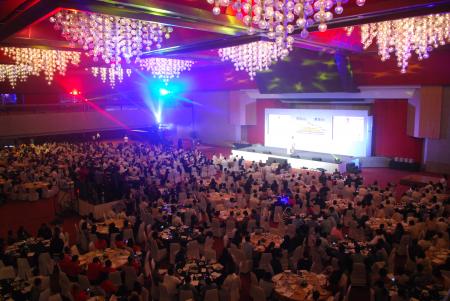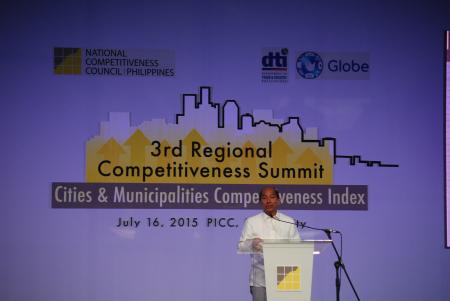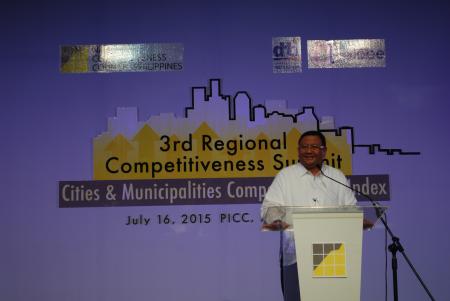- Home
- |
- About Us
- |
- Working Groups
- |
- News
- |
- Rankings
- WEF-Global Competitiveness Report
- Ease of Doing Business Report
- IMD-World Competitiveness Yearbook
- TI-Corruption Perceptions Index
- HF-Economic Freedom Index
- WEF-Global Information Technology Report
- WEF-Travel and Tourism Report
- WIPO-Global Innovation Index
- WB-Logistics Performance Index
- FFP-Fragile States Index
- WEF-Global Enabling Trade Report
- WEF-Global Gender Gap Report
- Gallery
- |
- Downloads
- |
- Contact Us
15 Cities, 17 Municipalities, 3 Provinces Recognized Most Competitive for 2015
July 16, 2015, Pasay City, Metro Manila – Over 1,000 delegates from local government units, national government agencies, and private sector gathered at the PICC Reception Hall to witness the announcement of the Most Competitive Cities, Municipalities, and Provinces in the 3rd Regional Competitiveness Summit.

This year, after two consecutive years of successful conduct of the Cities and Municipalities Competitiveness Index, the National Competitiveness Council, through the help of the Regional Competitiveness Committees, covered 142 Cities and 978 Municipalities out of a total of 1,634 localities, or a 68% national coverage versus only 17% coverage in the first year of the program, and 33% in the second year. Based on the framework of the index, these LGUs were ranked on three pillars – Economic Dynamism, Government Efficiency, and Infrastructure. With the objective to accurately rank the locality’s competitiveness, LGUs were classified according to 4 categories: 3rd to 6th Class Municipalities, 1st to 2nd Class Municipalities, Component Cities, and Highly Urbanized Cities.
Under the Economic Dynamism Pillar, for the 3rd to 6th Class Municipalities Category, Jagna, Bohol placed third, Mambajao, Camiguin placed second, and Nasipit, Agusan Del Norte secured the first place. For the 1st to 2nd Class Municipalities Category, Lupon, Davao Oriental ranked third, Santa Maria, Bulacan ranked second, and General Trias, Cavite got the first place. For the Component Cities Category, Tagum of Davao Del Norte placed third, Imus, Cavite placed second, and Naga. Camarines Sur secured the first spot. For the Highly Urbanized Cities Category, Paranaque City placed third, Makati City, Second, and Quezon City placed first.

Under the Government Efficiency Pillar, for the 3rd to 6th Class Municipalities Category, Jimenez, Misamis Occidental was ranked third, Mambajao, Camiguin ranked second and Paoay, Ilocos Norte got the first spot. For the 1st to 2nd Class Municipalities Category, Agoo, La Union got the third place, Midsayap, North Cotabato for second place, and Santa Barbara, Iloilo got the first place. For Component Cities Category, San Fernando, Pampanga got the third place, Kidapawan, North Cotabato second place, and Naga, Camarinus Sur first place. For Highly Urbanized Cities Categoy, Makati City ranked third, Cagayan de Oro ranked second, and Iloilo City ranked first.
Under the Infrastructure Pillar, for the 3rd to 6th Class Municipalities Category, Infanta, Quezon placed third, Baler, Aurora placed second, and Taal, Batangas placed first. For the 1st to 2nd Class Municipalities Category, Taytay, Rizal placed third, Malay, Aklan placed second, and Angono, Rizal got the first place. For the Component Cities Category, Antipolo, Rizal placed third, Dasmariñas, Cavite second, and Naga, Camarines Sur secured first place. For Highly Urbanized Cities category, Zamboanga City placed third, Cebu City placed second, and Manila City secured first place.
The Overall Most Competitive Municipalities under the 3rd to 6th Class Municipalities Category are Infanta, Quezon City in third place, Baler, Aurora in second place, and Mambajao, Camuigin was awarded the Most Competitive Municipality for this category. Under the 1st to 2nd Class Municipalities Category, Taytay, Rizal got the third place, Santa Maria, Bulacan at second place, and General Trias, Cavite bagged the overall most competitive municipality for this category.
The Overall Most Competitive Cities under the Component Cities Category are Imus, Cavite in third place, San Fernando, Pampanga in second, and Naga, Camarines Sur in first place. For the Highly Urbanized Cities Category, Cebu City secured the third place, Makati City got the second place, and Manila City was awarded the most competitive city under this category.
To get the Most Competitive Provinces, NCC introduced a new method to rank the qualified provinces for the index. For a province to qualify in the ranking, the combined population of all participating LGUs under the province should constitute at least 60% of the TOTAL PROVINCIAL POPULATION. For those provinces which qualify given this specific condition, the scoring is calculated as the population and income weighted average of the LGUs covered. Scores of the LGUs covered are then aggregated. Following this framework, the Province of Cebu got the third place, Province of Misamis Oriental got the second place, and the province of Davao Del Sur was awarded the most competitive province for 2015.
Among 978 participating municipalities, Mambajao, Camuigin received the most number of recognitions with three recognitions, and, among 142 cities, Naga City, Camarines Sur received a total of four recognitions.
The summit, which emphasized the importance of local competitiveness as the foundation of national competitiveness, gathered Local Chief Executives, leaders from both the Private and Public Sectors, and delegates from across the country. The awards were conferred and presented by prominent leaders from different sectors, which further underscored the value of the recognition. The award conferrers included Assistant Secretary Rafaelita Aldaba, Undersecretary Nora Terrado, and Undersecretary Zenaida Maglaya of the Department of Trade and Industry; Mr. Edgar Chua, Country Chairman of Shell Philippines; Mr. Cesar Bautista, former Secretary of DTI; Ms. Jane Yuan Xu, Country Director of the International Finance Corporation; Mr. Dondi Mapa, National Technology Officer of Microsoft Philippines; Atty. Miguel Varella, President of the Philippine Chamber of Commerce and Industry; Mr. Ebb Hinchcliffe, Executive Director of the American Chamber of Commerce of the Philippines; Undersecretary Richard Moya of the Department of Budget and Management; Mr. John Avila, Project Management Specialist of the Office of Economic Development and Governance, USAID Philippines; Undersecretary Corazon Jimenez, General Manager of the Metropolitan Manila Development Authority; Mr. Julian Payne, President and CEO of the Canadian Chamber of Commerce of the Philippines; Mr. Henry Schumacher, Executive Vice President of the European Chamber of Commerce of the Philippines; Dr. Kenneth Y. Hartigan-Go, Undersecretary of the Department of Health; Mr. Anthony Lau, Head of eGov Group of Globe Telecom; Mr. Guillermo Luz, Private Sector Co-Chair of the National Competitiveness Council; Secretary Florencio B. Abad of the Department of Budget and Management; and Secretary Jose Rene Almendras, Cabinet Secretary. The presenters, on the other hand, included Mr. Virgilio Fulgencio, Public Sector Director for Operations of the National Competitiveness Council; Ms. Ofelia Templo, former Chief of Party USAID-INVEST; Mr. Ruy Moreno, Private Sector Director for Operations of the National Competitiveness Council; Ms. Tammy Lipana, President of Isla Filipina Foundation; Dr. Alvin Ang, CMCI Consultant and Economics Department Faculty Member, Ateneo De Manila University; Ms. Helen Macasaet, President and CEO of Pentathlon Systems Resources, Inc.; Mr. Ernesto Ordoñez, Private Sector Champion for Anti-Smuggling and Import-Export Documentation of the National Competitiveness Council; Mr. John Forbes, Senior Adviser of the American Chamber of Commerce of the Philippines; and Ambassador Donald Dee, Chairman Emeritus of the Employers Confederation of the Philippines.

Hon. Florencio B. Abad, Secretary of the Department of Budget and Management, delivered the keynote message prior to the formal announcement of winners and awarding, while Hon. Jose Rene Almendras, Cabinet Secretary, delivered the closing message. Both Secretaries spoke about the huge potential of the Philippines to be truly globally competitive through the growth and development of local governments. They recognized and praised the efforts and commitment of all Local Chief Executives, Governors, and their constituents as they traverse the road of excellence towards competitiveness. Mr. Guillermo Luz capped the program with the official launch of the CMCI website. The updated website consolidates and presents all the data submitted by the local government units. The Index may be used by the public sector and local government units to assess the state of development of the locality; by the private sector as a reliable source of pertinent information for business and investment decisions, and the academe for focused research and development studies.

The 3rd Regional Competitiveness Summit was streamed live online, powered by Globe Telecom, the Major Sponsor of the event. ANC – The ABS-CBN News Channel also supported the National Competitiveness Council as the Media Partner. The event was hosted by Award-Winning Broadcast Journalist Ms. Ces Oreña-Drilon.
The Cities and Municipalities Competitiveness Index is a program which encourages LGUs to gather and voluntarily submit data which are used to measure their performance on three pillars anchored on global standards: Economic Dynamism, Government Efficiency, and Infrastructure. Each pillar has indicators which provide a more detailed view of the economic status of the locality. There are 8 indicators for Economic Dynamism and 10 indicators for both Government Efficiency and Infrastructure, totaling 28 indicators. The data submitted by the Local Government Units, through the assistance of a partner Academe and the Regional Competitiveness Committees, is used for the final scoring and ranking.
This program is conducted by the National Competitiveness Council, aligned with the goal to improve the country’s overall competitiveness, through collaborative efforts between the national and local government agencies, and the public and private sectors.

